Useful electronic homemade products
 As the size of the site bgv.electricianexp.com is becoming more and more every day, there are many new articles, it is quite difficult for new visitors to immediately navigate and review at a time everything already written and previously posted.
As the size of the site bgv.electricianexp.com is becoming more and more every day, there are many new articles, it is quite difficult for new visitors to immediately navigate and review at a time everything already written and previously posted.
I really want to draw the attention of all visitors to individual articles that were posted on the site earlier. In order to not have to search for the necessary information for a long time, I’ll make a few “input pages” with links to the most interesting and useful articles on specific topics.
The first such page will be called "Useful electronic homemade products." Here we consider simple electronic circuits that are available for implementation to people of any level of training. All information in the articles is presented in a very accessible form and in the amount necessary for practical work ...
Schemes of amateur frequency converters
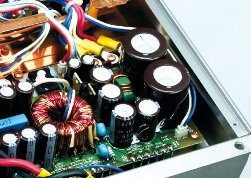 One of the first inverter circuits for powering a three-phase motor was published in Radio magazine No. 11 of 1999. Scheme developer M. Mukhin at that time was a student of grade 10 and was engaged in a radio circle.
One of the first inverter circuits for powering a three-phase motor was published in Radio magazine No. 11 of 1999. Scheme developer M. Mukhin at that time was a student of grade 10 and was engaged in a radio circle.
The converter was intended to power the miniature three-phase motor DID-5TA, which was used in the machine for drilling printed circuit boards. It should be noted that the operating frequency of this engine is 400Hz, and the supply voltage is 27V. In addition, the midpoint of the motor (when connecting the windings with a “star”) was brought out, which made it possible to extremely simplify the circuit: it took only three output signals, and each phase required only one output key. As can be seen from the diagram, the converter consists of three parts: a three-phase pulse generator-shaper: a three-phase pulse generator-shaper on microcircuits ...
Industrial frequency converters
 In industrial environments, three-phase asynchronous motors are most commonly used. The simplicity of their design, reliability and low cost - these are the decisive factors that allow you to use them in many machines, units and mechanisms. In most cases, engines operate on an on-off basis.
In industrial environments, three-phase asynchronous motors are most commonly used. The simplicity of their design, reliability and low cost - these are the decisive factors that allow you to use them in many machines, units and mechanisms. In most cases, engines operate on an on-off basis.
In almost all metal-cutting machines, the spindle speed is controlled by a mechanical gearbox. Moreover, it is not necessary to control the engine speed to change or maintain any technological parameter in the norm. As such a parameter, for example, one can consider the pressure at the outlet of a conventional water pump used in plumbing systems. Each of us is familiar with this parameter - just open the washbasin tap in the morning. About twenty years ago, the task of regulating pressure ...
The electrical circuit of the power supply for the garage
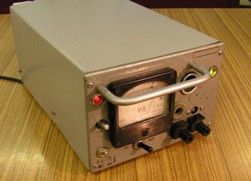 Let me remind you that this is a diagram of a specific instance of the device and some of its parts may look redundant, and the parameters of individual elements with a large margin. Nevertheless, it was tuned and adjusted to the actual operating conditions and is fully operational.
Let me remind you that this is a diagram of a specific instance of the device and some of its parts may look redundant, and the parameters of individual elements with a large margin. Nevertheless, it was tuned and adjusted to the actual operating conditions and is fully operational.
The purpose of the individual elements of the circuit and the operation of the device is more convenient to consider in the following block diagram.
1. Transformer and rectifiers; 2. The voltage reference driver for a short-circuit protection circuit; 3. Active element of protection against short circuit; 4. Shaper of the reference voltage for the stabilization circuit and adjust the output voltage; 5. The node for adjusting the output voltage; 6. The active element of the stabilization and adjustment of the output voltage; 7. Regulating transistors; 8. The node display parameters of the output voltage ...
Isolation transformer in a home electrician workshop
 An isolation transformer is a transformer that is designed for electrical (experts say - galvanic) separation of the power supply network and the consumer of electricity. Consumers are us and why divide us? For safety!
An isolation transformer is a transformer that is designed for electrical (experts say - galvanic) separation of the power supply network and the consumer of electricity. Consumers are us and why divide us? For safety!
The main task of the isolation transformer is to increase electrical safety due to the fact that its secondary circuits do not have electrical connection with the ground, and therefore with the grounded neutral of the transformer substation - a voltage source.
In this case, the occurrence of an electrical breakdown on the case does not cause overcurrents, and the device itself remains in working condition. If a person accidentally touches a part of the device that is accidentally energized, the leakage current will not exceed a life-threatening threshold and tragedy will not happen ...
We solder radio components from old boards
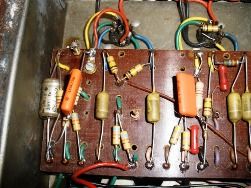 There are many different ways to solder radio components from circuit boards with a view to their further use. Of course, preference should be given to professional techniques and devices for the dismantling of radio elements. However, it is unlikely that professionals with serious special equipment need transistors, resistors, and other amateur radio tricks obtained in this way.
There are many different ways to solder radio components from circuit boards with a view to their further use. Of course, preference should be given to professional techniques and devices for the dismantling of radio elements. However, it is unlikely that professionals with serious special equipment need transistors, resistors, and other amateur radio tricks obtained in this way.
So we’re talking, of course, about home technology. And more precisely, I would like to share just a couple of simple tricks that will certainly accelerate this desired process. So, we will talk about the procedure for extracting the necessary parts from old boards or boards that are not intended for further restoration. I’ll make a reservation that we are not talking about chip desoldering, there you need a thinner approach ...
Homemade dimmers. Part Five Some more simple schemes
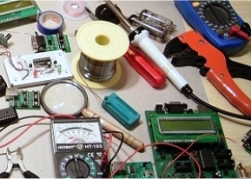 A dimmer on the analog of a single junction transistor. Despite the absolute dissimilarity of the schemes at first glance, they work almost identically. The brightness of the lamp is controlled by the phase method of controlling the thyristor, however, the load connection is somewhat different.
A dimmer on the analog of a single junction transistor. Despite the absolute dissimilarity of the schemes at first glance, they work almost identically. The brightness of the lamp is controlled by the phase method of controlling the thyristor, however, the load connection is somewhat different.
In the considered circuit, the regulator load, a light bulb, is included in the diagonal of the rectifier bridge for alternating current. The thyristor itself is included in the diagonal by a constant, rectified current.
On transistors VT1, VT2 assembled node smooth start, but for now, consider the operation of the regulator. If we mentally draw a vertical line between the VT2 transistor and resistors R3 and R4, then everything that turns out to be to the right of this line is actually a dimmer ...
Homemade dimmers. Part Four Thyristor Practical Devices
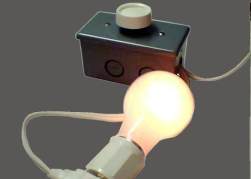 The basis of dimmers and power regulators are, as a rule, thyristors and triacs. The operation of these semiconductor devices was described in the previous three parts of the article, and now you can get acquainted with the device of some practical devices on thyristors. All schemes that will be considered use the phase regulation principle described at the end of the third part of the article.
The basis of dimmers and power regulators are, as a rule, thyristors and triacs. The operation of these semiconductor devices was described in the previous three parts of the article, and now you can get acquainted with the device of some practical devices on thyristors. All schemes that will be considered use the phase regulation principle described at the end of the third part of the article.
First, let's get acquainted with fairly simple schemes containing a small amount of detail, and at least therefore, the most affordable for repetition in amateur conditions. However, the circuits may be more complex, but the algorithm for their operation is still the same - adjusting the brightness of the light source. Sometimes there are circuits that combine the dimmer and twilight switch itself, or a scheme for smoothly turning on the lamp ...
